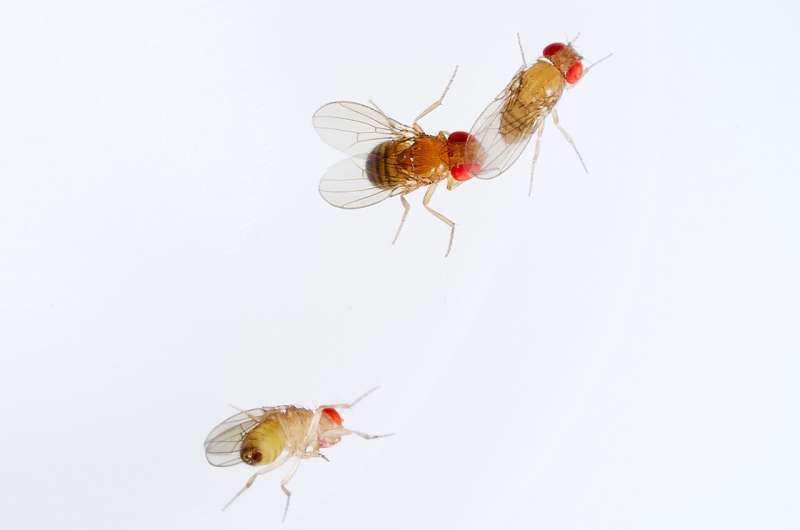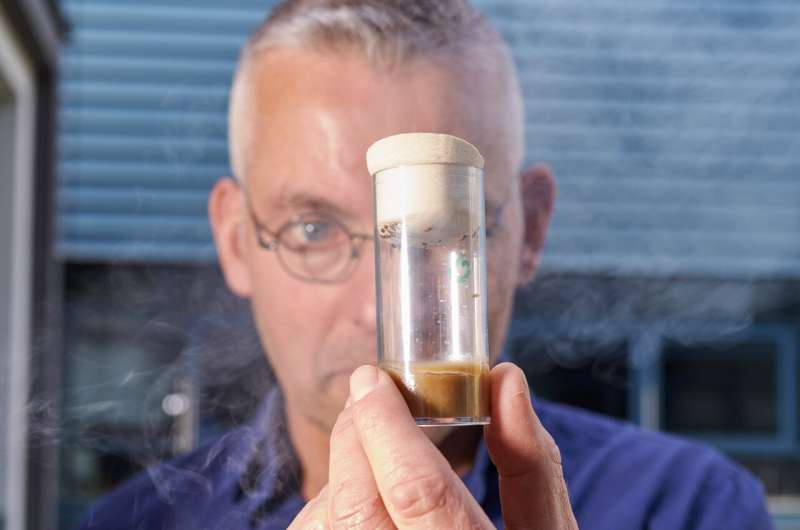This article has been reviewed according to Science X's editorial process and policies. Editors have highlighted the following attributes while ensuring the content's credibility:
fact-checked
peer-reviewed publication
trusted source
proofread
Oxidant pollutant ozone removes mating barriers between fly species, study finds

Insect pheromones are odor molecules used for chemical communication within a species. Sex pheromones play a crucial role in the mating of many insects. Species-specific odors attract males and females of the same species. At the same time, they maintain the natural boundaries between species.
The research team led by Nanji Jiang, Bill Hansson and Markus Knaden from the Department of Evolutionary Neuroethology at the Max Planck Institute for Chemical Ecology has previously shown that elevated ozone levels severely disrupt chemical communication within fly species: Ozone breaks the carbon-carbon double bonds found in most insect pheromones. As a result, male flies can no longer distinguish between females and other males and therefore court both sexes.
In their new study published in Nature Communications, the researchers investigated whether the degradation of sex pheromones by ozone also affects the mating boundaries between different species.
"In particular, we wanted to know whether elevated ozone levels remove mating boundaries between species and what the consequences of a possible hybridization are. We know from previous experiments that ozone can severely disrupt mate choice in insects.
"Our current study indicates that even slightly elevated ozone levels, which nowadays are not uncommon on summer days in many places, cause flies to hybridize more frequently with closely related species, which could lead to a decline in insect populations due to the infertility of the resulting hybrids," says first author Nanji Jiang, summarizing the key message of the study.

Inter-species mating occurs under elevated ozone levels
The scientists chose four species of the genus Drosophila for their experiments. While Drosophila melanogaster and Drosophila simulans are cosmopolitan species found all over the world, their relatives Drosophila sechellia and Drosophila mauritiana are island-endemic and, as their names suggest, are only found in the Seychelles and Mauritius respectively.
All four species use very similar pheromones, but mix them in a species-specific way. It was therefore crucial for the research team to be able to measure the quantitative changes within the pheromone mixtures after exposure to ozone.
In the mating experiments, the flies were exposed for two hours to ozone concentrations that are often measured on particularly hot days in our cities. The scientists gave ready-to-mate females the opportunity to choose between a male of the same species and a male of a different species.
After a few hours, they separated the females from the males and allowed them to lay eggs. To determine whether the female had mated with a male of her own species or another species, the researchers analyzed the sexual organs of the male offspring, as species and hybrids can be distinguished on the basis of their morphology.
The results of these tests showed that hybridization occurred more frequently under the influence of ozone, while few hybrids were found when the flies were previously exposed only to ambient air.
Fruit flies rely not only on chemical signals to mate, but also on the singing of species-specific songs, which they produce by vibrating their wings. Many species also use visual signals to attract mating partners. Despite these additional "aids," elevated ozone levels appeared to prevent some of the female flies in the study from distinguishing between conspecifics and males of other species.
"Although we expected that the disruption of pheromone communication by ozone would lead to a slight increase in hybrids, we were surprised to find that some females were completely unable to discriminate between conspecifics and males of other species, despite other possible acoustic or visual cues," says Bill Hansson, Head of the Department of Evolutionary Neuroethology.

Hybrids: A dead end in evolutionary terms
Male hybrids in flies are usually sterile or at least less fertile than non-hybrids. Male hybrid offspring is therefore a wasted investment for the flies and can contribute to the extinction of populations. Unlike male hybrids, female hybrids are usually fertile and in some cases were even preferred by males in this study. Female hybrids could therefore be a source of continuous gene flow, which in the long term could lead to the emergence of hybrid species.
"The genus Drosophila comprises more than 1500 species, and it is known that more than 100 closely related species pairs can potentially hybridize. It is therefore not unlikely that pollutant-induced hybridization in some of these species pairs could lead to hybrid speciation," says Knaden, assessing the chances of success of such a hybrid species.
Air pollution is an underestimated threat to insects
Insects rely on odors, not only when choosing a mate. In addition to sex pheromones, they use aggregation pheromones to attract conspecifics of both sexes or alarm pheromones to communicate in case of danger. Social insects, such as ants, navigate along pheromone trails or use colony specific odors to recognize their nest mates.
Many of these odor molecules also contain carbon-carbon double bonds, which can be broken by ozone. The scientists fear that ozone could disrupt the chemical communication of insects in many areas, and now plan to investigate this in further studies, for example in ants.
Outside the laboratory, other oxidizing pollutants such as nitrogen oxides, which cannot be tested in laboratory experiments because of their toxicity, can amplify the effect of ozone. Limit values already exist for these pollutants because of their harmful effects on humans.
"The limits for air pollutants should be re-evaluated, considering that even small amounts of these substances have a significant impact on the chemical communication of insects," says Knaden. "As we are currently facing a dramatic decline in insect populations regarding their total biomass and their biodiversity, we should try to better understand and counteract all possible factors that potentially favor this decline."
More information: Elevated ozone compromises mating boundaries in insects, Nature Communications (2024). DOI: 10.1038/s41467-024-47117-7
Journal information: Nature Communications
Provided by Max Planck Society
















